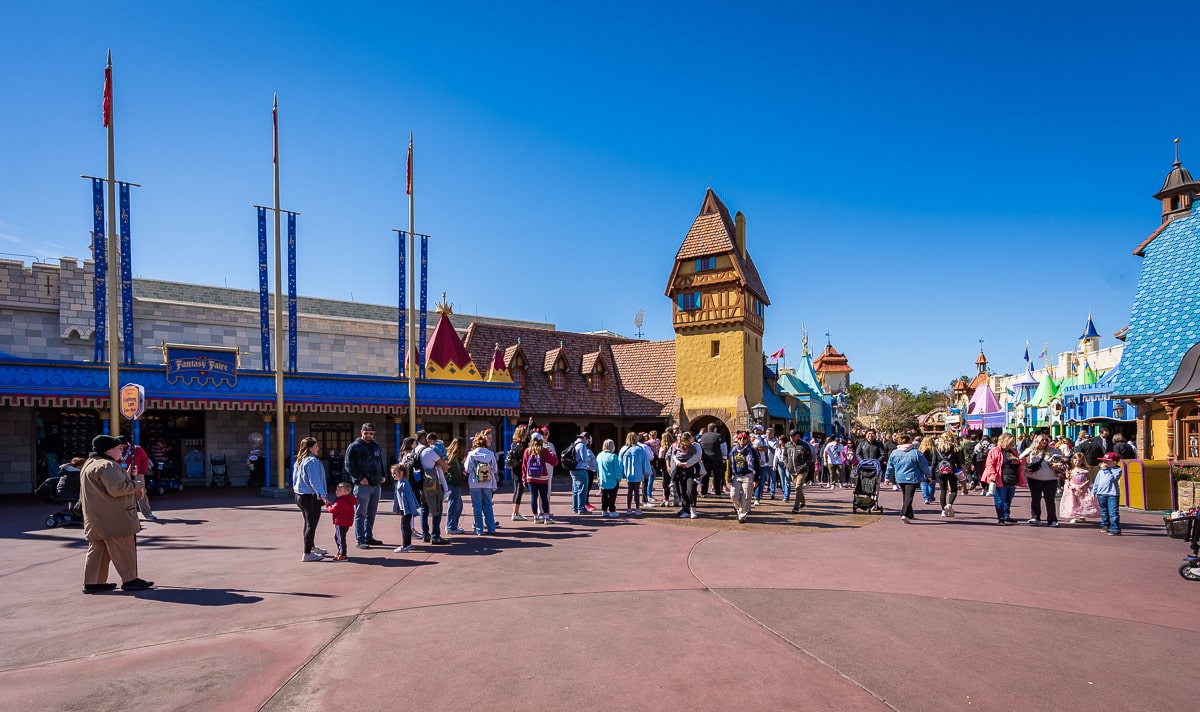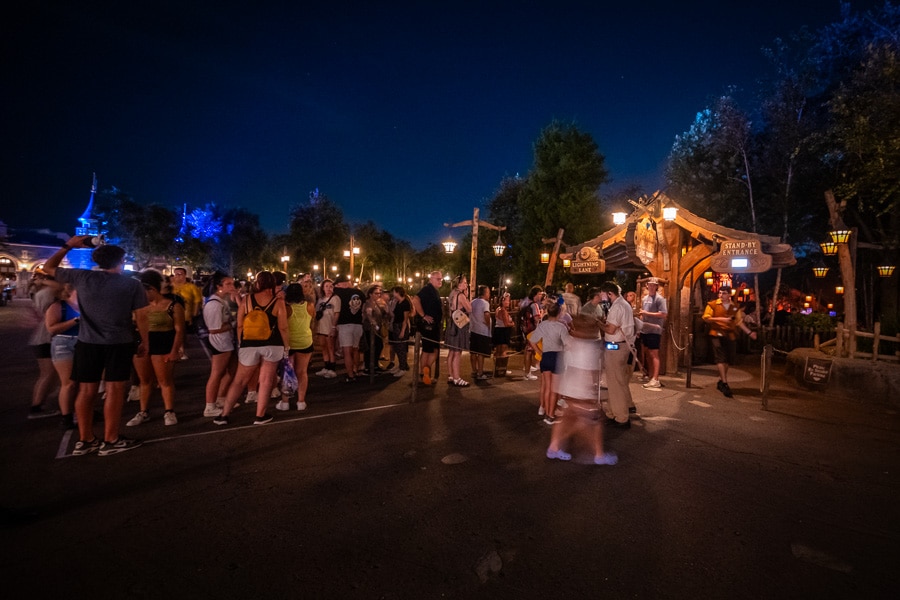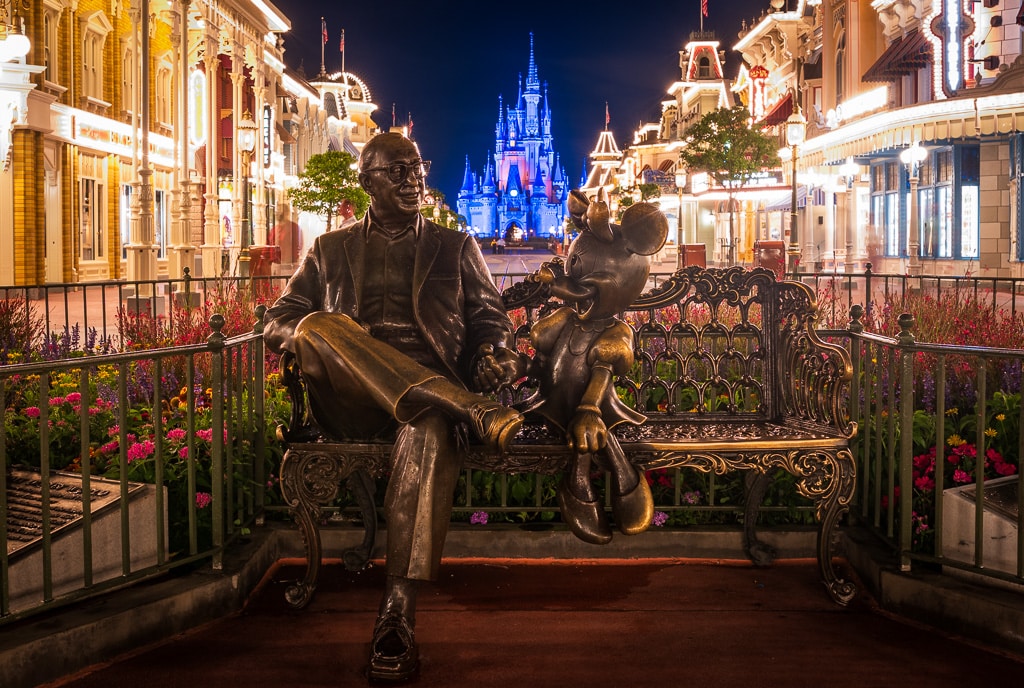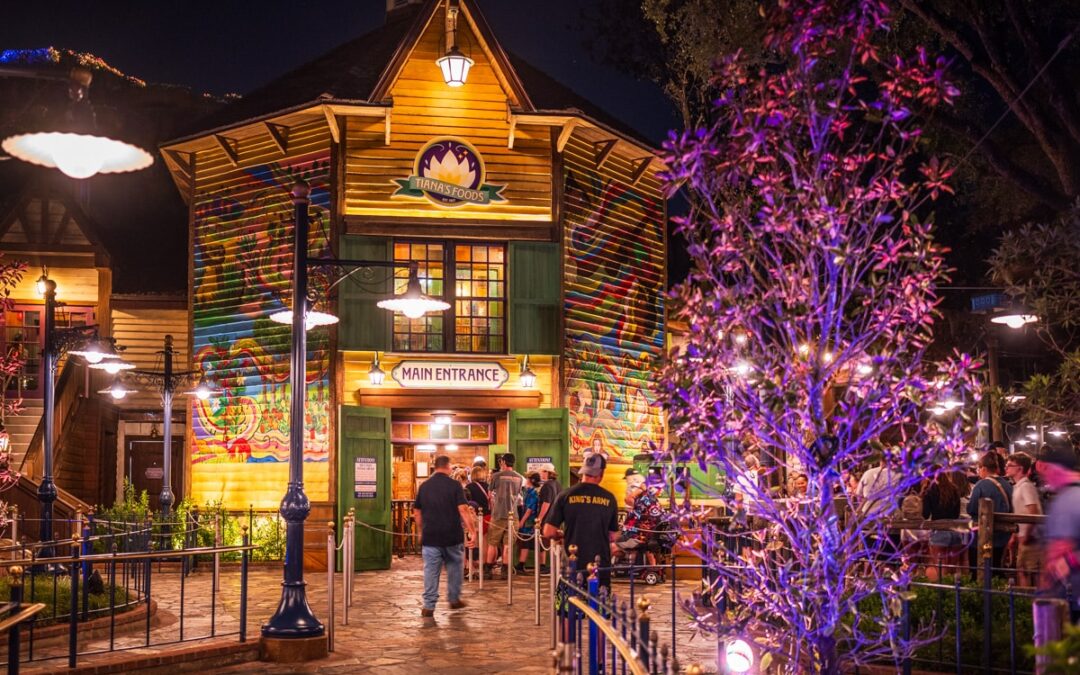
Walt Disney World continues to tweak queue capacity allocations, and that on top of changing crowd patterns and higher prices has resulted in a different value proposition for Lightning Lane Multi-Pass. This looks at wait times for standby lines, LLMP availability, plus our experiences and reader reports to explain how things have changed in 2025 and help you determine whether Lightning Lanes are still “worth it” or if sticking to free standby plus savvy strategy is good enough.
This is a topic we first addressed last year in Here’s Why Standby Lines & Lightning Lanes Are Moving Faster at Walt Disney World. I don’t want to simply rehash that post and would also like this to be more concise, so I’m going to build on a few of the conclusions there while also presupposing others.
Crowd levels are generally down at Walt Disney World on a year-over-year basis since last February. This does not mean that wait times are low–it means that they’re, on average, lower than the same timeframes as last year. Meaning Spring Break 2025 was still slammed, but not as slammed as last year. Summer is already heating up–you might encounter a 75 minute wait for Slinky Dog Dash, whereas it might’ve been 90 minutes last year. Still a long wait, but not an insignificant difference!
But as we often point out, crowd levels as determined by wait times (an imperfect measure, but the only worthwhile one) are not the same as ‘feels like’ crowds or congestion. The latter is more comparable to attendance (still imperfect, but closer). Basically, wait times don’t tell the full story.
For about the last year, there’s been even more of a divergence between wait times and crowds or attendance, with the former dropping more than the latter. In fact, wait times have continued decreasing in 2025 even as executives have indicated that bookings are up at Walt Disney World year-over-year. Attendance is increasing even as wait times are decreasing. How can that be reconciled?
Our theory: lower use of the Lightning Lanes is the primary driver of lower standby wait times. Fewer guests are skipping the line, and are instead in the regular line (or doing something else entirely). This would explain why the standby lines are moving more fluidly and why wait times are lower–because fewer guests are in the Lightning Lanes, being prioritized and pulled in front of standby lines.


Under Genie+ and FastPass, standard operating procedure called for a roughly 4:1 or 80:20 ratio of ‘fast lane’ to standby guests at the the attraction’s merge point. This meant that for every 10 parties boarding an attraction, 8 were pulled from the Lightning Lane and 2 were pulled from standby.
This was the baseline–the ratio only gets less favorable for the standby line! When there was elevated demand, Cast Members had the discretion to adjust that merge to a 90:10 ratio. From there, the ratio can be adjusted up even further, which only happens in the event of extended downtime and a backlog of Lightning Lane guests.
This is accompanied by an arbitrarily high wait time being posted to discourage guests from getting in the standby line. Because even though these guests might see a short line, it’s nevertheless a long wait. The whole goal is to process the backlog of Lightning Lane guests. None of this is anything new–these ratios have existed since the FastPass days.
That’s why standby lines can move at a snail’s pace with FastPass/Lightning Lanes, because those guests are progressing through the line slower. It’s (almost) all about the ratio. There could be 200 guests in the Lightning Lane and 50 in the standby line, but if the pull ratio is 90:10, the 199th guest in the Lightning Lane will still board before the 30th guest in the standby line.


As I shared in our previous update late last year, my experience in the standby lines over the course of the last year has definitely not been that 4 people are being pulled from the Lightning Lane for every one guest from the standby line.
Thus far in 2025, I’ve been doing extensive testing for overhauled itineraries and with the switch to standby for Cosmic Rewind, Tiana’s Bayou Adventure, and TRON Lightcycle Run. Anecdotally, this has more or less confirmed what I previously suspected: the ratio is now fairly close to 1:1. That’s one party from standby for every party from the Lightning Lane.
For what it’s worth, this can still skew in favor of the Lightning Lane. Walt Disney World operations still has a mandate to prioritize Lightning Lane guests and ensure their wait times are kept to a minimum. So if there’s a backlog of guests in the Cosmic Rewind Lightning Lane, for example, due to downtime or at Peter Pan’s Flight post-parade, those guests will still be processed first, tipping the scales back in favor of the Lightning Lane. But during normal times, I’d ballpark it at 1:1.


While I reported my suspicions of this months ago, my recent testing has further reinforced that this is happening. And I’m not the only one that’s been watching this. TouringPlans recently released their own field testing results, offering corroboration. They arrive at the same 1:1 conclusion, with a sliding scale of 2:1 and 3:1–still lower than the old model under FastPass. They also suggest that less park capacity has been set aside for Lightning Lane guests.
There are a couple of ways that our conclusions differ. The first is that they suggest this is a recent development as of 2025. While I would agree that the practice has become more pronounced this year, I observed (and wrote about) this pattern last year. It felt noticeable during above-average holiday dates between Veterans Day and Christmas.
They conclude that the changes are great for guests in standby lines, resulting in shorter waits. I strongly agree with this–it’s pretty inarguable–and think it’s worth underscoring a few times. Standby lines are moving faster and the wait times are lower–that was literally our previous headline. A huge win for guests sick of upcharges.
However, their flipside conclusion is that guests using Lightning Lanes will have “marginally longer” waits. I could see how this inference might be drawn from the data, but my on-the-ground observations don’t really support this. From what I’ve seen, the opposite is true. On its face, that may not make sense. Ride capacity is what it is, so gains for standby come at the expense of Lightning Lanes–and vice-versa, right?


One way we can judge Lightning Lanes is by simply looking at them. There are several other attractions that used to regularly use overflow queues for the Lightning Lanes. There were times when Peter Pan’s Flight would back up past PhilharMagic, Seven Dwarfs Mine Train would have multiple switchbacks (via tape on the ground), Space Mountain had a line out to the TTA track, etc.
This can still happen from time-to-time, especially on peak days or after rides return from excessive downtime. But it was previously occurring with regularity, even on off-season days. I haven’t seen Lightning Lanes that consistently backed up in the last ~11 months. It’s a night-and-day difference.
This supports an alternative hypothesis: what if instead of the ratio being changed to favor standby and increase waits for Lightning Lanes, that fewer Lightning Lanes are being issued in the first place? That it’s not the tail wagging the dog–the ratio is not what changed first, but is an indirect byproduct of lower utilization of line-skipping? (In other words, it’s supply side–fewer Lightning Lanes are being distributed.)


In combing through the data and listening to Disney’s earnings calls, the explanation for this is not Lightning Lane Multi-Pass or Single Pass having lower demand than their predecessors. To the contrary, Lightning Lane Single Pass is selling out much more often than Individual Lightning Lanes did, even in low to moderate crowd levels.
We’ve observed higher demand and more limited inventory for Lightning Lane Multi-Pass and Single Pass. Several different Lightning Lanes fully book up in advance and have limited same-day availability, including some that never were difficult with the Genie+ system. As for the ‘why’ of this, our best explanation is heightened FOMO and FUD.
Since guests are no longer buying Lightning Lanes same-day, it’s more difficult to assess the need for them and adjust accordingly during your vacation. As such, there’s likely a tendency to “over-purchase” Lightning Lanes as compared to under the old system. (Another subject that’s beyond the scope of this post, but it’s worth reading our recent post: When You Should Skip Lightning Lane Multi-Pass.)


I’ve noticed this with regularity when field testing Lightning Lane Multi-Pass. Not just that time slots are filling up in advance and some rides are ‘selling out’ of Lightning Lane inventory several days in advance, but also that same-day drops are less common. (They still occur, you just have to work more for them.)
All of this and more is discussed in our new Top 10 Tips & Tricks for Lightning Lanes at Walt Disney World in 2025, with fresh recommendations for adapting to all of the major changes from Genie+ to Multi-Pass that we’ve experienced in practice. (Not just theoretical or policy/rule changes.) One big change is that Disney’s Hollywood Studios has become the #1 park for LLMP, dethroning Magic Kingdom, which used to be the best park thanks to its ride roster.
That changed largely due to more difficult same-day availability and ride reservation refills at Magic Kingdom. You can still leverage the rolling 3 rule if you put a little elbow grease into your refresh game, but it’s more difficult at Magic Kingdom than it used to be. I would hazard a guess that the average guest (not you) is obtaining fewer worthwhile Lightning Lanes per day than before on moderate crowd level days at MK. We’ve also heard this from readers, many of whom are high-knowledge guests who have done “worse” with Lightning Lane Multi-Pass.
It’s also supported by thrill-data, which tracks Lightning Lane availability. It has decreased markedly in the Lightning Lane Multi-Pass/Single Pass era. All of this supports a conclusion that Walt Disney World has throttled Lightning Lane supply.


This isn’t occurring in isolation. It’s also been occurring alongside the overhaul of Disability Access Service to reduce abuse and misuse. It’s our understanding that this is what’s having the biggest impact on both wait times and decreased utilization of Lightning Lanes.
It’s all but certain that the DAS overhaul is one of the primary reasons for shorter standby lines and less Lightning Lane usage. This was one of the driving forces behind the crackdown, so it makes sense. Even prior to the overhaul announcement, we had heard that DAS usage had exploded and DAS utilization outpaced paid sales of Lightning Lanes.
Disney has been sued over accommodations for disabled guests in the past, and these stats have come out during discovery and testimony. A test study during that revealed that DAS users experienced, on average, 45% more attractions than those without DAS. And that study was under the old system that was harder to use and had less abuse.
We’d be remiss if we didn’t mention here that this DAS crackdown came at the expense of disabled guests who need DAS in order to enjoy Walt Disney World. While it’s good to see the abusers being denied, there has been collateral damage. Many guests who are actually disabled have been swept up in the crackdown–it’s unfortunate there’s no way to narrowly target the abusers. I won’t pretend to know what the “perfect” solution is–but some of the stories to come out of the status quo are heartbreaking.
However, this is about shorter standby lines and lower Lightning Lane usage despite demand. Given all of the above, it’s impossible to reconcile all of that without attributing it to the DAS overhaul. There are other contributing factors, but a primary driver is undoubtedly DAS.


DAS is not the only driver, though. As mentioned above, the availability we’re seeing in our field testing and data strongly suggests less inventory for paid Lightning Lanes, too. This is fascinating, because the DAS crackdown could theoretically yield the opposite–more inventory. And yet, that has not been our experience. It’s as if two big dials are being adjusted at once, and both in the same direction.
This is further reinforced by Lightning Lane Multi-Pass not selling out during the holiday season or spring break, which used to happen with regularity under Genie+. In all likelihood, this is because Disney is managing inventory for the Lightning Lanes, allocating fewer to each guest who is utilizing the system.
That kind of begs the question: if less inventory is being utilized by DAS and by paid Lightning Lanes, where is it going? Who is the winner under this system? As already discussed above, guests in the standby lines–this is precisely why regular wait times are shorter (and also, not longer for guests in Lightning Lanes). They’re not the only ones, though.


Another winner is guests who purchase Lightning Lane Premier Pass. This isn’t to say that they were really losers before, as that product offering has remained static since its launch. However, the marginal value for LLPP has arguably increased since its launch. This is especially true when you compare product offerings. If the average guest who buys Multi-Pass is only getting 4-5 “good” Lightning Lanes instead of all or most of them, the value of LLPP is not just in convenience, lack of screen time, etc. It also offers more utility than the alternative.
In theory, it makes sense that Walt Disney World would want to differentiate its product offerings, throttling Lightning Lane Multi-Pass to some degree to improve the value proposition of Lightning Lane Premier Pass by comparison. In actuality, I wonder if this was the primary motivation. Lighting Lane Premier Pass is a rather niche product with an exceedingly limited target audience.
Making Multi-Pass less useful is less likely to push people towards LLPP than it is to push them towards nothing at all–free standby lines. The cost disparity is the real hurdle for the vast majority of guests, not product differentiation. Volkswagen throttling the speed of the Beetle wouldn’t be a savvy strategy for pushing people to purchase the Porsche 911. That’s not how it works.


Consequently, this once again brings us back to guests in standby lines as the biggest winners. The last ~5 years have made a lot of Walt Disney World fans more cynical towards the company, me included. And for good reason! Even before I hit publish, I can hear you doubting this conclusion (that’s right, the skepticism is so strong that I can already hear it via some time warp kinda deal). Once you’re done laughing at the possibility of Disney improving the “free” guest experience at the expense of the paid upcharge, hear me out.
Guest satisfaction and intent to return or recommend metrics took a beating after the honeymoon period post-reopening due to various cuts, while also implementing policies that many fans hated. We’ve discussed all of this at length, explaining that improving these metrics has been the driving factor behind making other guest-friendly changes in the last couple of years.
This is a topic that again reared its ugly head in Walt Disney World is Worried About Its High Prices, which covered how alarms are being sounded inside the company. Some executives fear that price increases, nickel & diming, etc. are alienating fans, souring sentiment, and pricing out the middle class. About a month after that leaked, Walt Disney World went on an all-out discounting and marketing blitz, with a flurry of deals that make this summer the cheapest time to visit Walt Disney World since (at least) 2019. The whole discount side of the “Cool Kid Summer” campaign should’ve vindicated the reports of those internal alarms and worries.


Back when the DAS changes were announced last year, we indicated that the intended beneficiary was guests in the standby lines. That it wasn’t simply about freeing up capacity to sell more Lightning Lanes, but striking a better balance. That queueing is a zero-sum game, and internally, the view was that a small percentage of power users were reaping disproportionate rewards at the expense of the overwhelming majority. The goal was to normalize wait times across the board. It now seems that this was true by adjusting both free and paid line-skipping.
Honestly, it still comes as something of a surprise to me that Walt Disney World would do anything at the expense of paid Lightning Lane users since that risks lower satisfaction among higher spending guests, not to mention future sales. Not quite sure how to fully explain this. Perhaps leadership has been so satisfied with the overall guest satisfaction gains that it’s something they’re willing to tolerate.
Maybe they’ve managed to thread the needle, finding that the ‘sweet spot’ for high Lightning Lane buyer guest satisfaction is 4.12 lines skipped on average or 93 minutes saved waiting in line, as opposed to 4.47 lines and 108 minutes (all completely made-up numbers), as might’ve been the case under the Genie+ system. It’s also possible that the certainty of pre-booking alone increases guest satisfaction among buyers, even if they’re securing slightly fewer experiences on average (and again, averages aren’t the same as maximums–it’s still possible for top power users to outperform!). I really have no clue–just spitballing potential explanations.


Ultimately, that’s our theory to why standby lines are shorter and faster moving at the same time that Lightning Lane usage has decreased, even with demand for Multi-Pass and Single Pass appearing fairly strong. This strikes us as the only plausible conclusion that reconciles Disney’s quarterly results reporting higher bookings, lower average wait times data, decreased Lightning Lane availability, and our extensive experiences when testing.
It seems that Walt Disney World has achieved that desired better balance between interests of guests using standby lines and Lightning Lanes. As for the titular question about whether Lightning Lanes are still “worth it?,” our new rule of thumb is that you should probably make the purchase (or not) based on the ride reservations you’re able to make at the point of purchase, with the assumption that you’ll score one additional worthwhile Lightning Lane at DHS and two at Magic Kingdom with minimal effort, and perhaps a few more if you have a strong refresh game.
Really, the important thing is that you make an informed decision on the question as to whether Lightning Lanes are still worth the money to you, personally. The key here is to understand that standby lines are shorter and faster moving, with posted and actual wait times that are lower due to the ratio of Lightning Lanes to the standby line changing pretty dramatically.


As should be demonstrated by the forgoing, it’s the “why” of this that really matters. Whether Lightning Lanes are still worth it is going to be subjective–varying based on your budget, tolerance for waiting in lines, and other strategy. It also presupposes that line-skipping ever was worth it in the first place, which I don’t think was the case.
Personally, I’d still buy Lightning Lane Multi-Pass almost all of the time at Disney’s Hollywood Studios, most of the time at Magic Kingdom, less than half of the time at EPCOT, and almost never at Animal Kingdom (exception: December 22, 2025 to January 5, 2026). So there’s your answer if you’re really craving one, as opposed to a detailed explanation.
Planning a Walt Disney World trip? Learn about hotels on our Walt Disney World Hotels Reviews page. For where to eat, read our Walt Disney World Restaurant Reviews. To save money on tickets or determine which type to buy, read our Tips for Saving Money on Walt Disney World Tickets post. Our What to Pack for Disney Trips post takes a unique look at clever items to take. For what to do and when to do it, our Walt Disney World Ride Guides will help. For comprehensive advice, the best place to start is our Walt Disney World Trip Planning Guide for everything you need to know!
YOUR THOUGHTS
What’s been your experience with standby lines, Lightning Lanes, and the flow of both at Walt Disney World in the last year or so? Have you been able to score more, fewer, or about the same number of Lightning Lanes under Multi-Pass vs. Genie? Have you noticed any discernible differences? Would you recommend LLMP or just advise sticking to standby given these trends? Do you agree or disagree with my assessment? Any questions we can help you answer? Hearing your feedback–even when you disagree with us–is both interesting to us and helpful to other readers, so please share your thoughts below in the comments!

